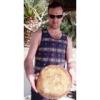
New Breads from Old Favourite Flours
 New Breads from Old Favourite Flours
New Breads from Old Favourite Flours
Our next-door neighbours recently took a daytrip to my old stomping ground across the North Pennines in Cumbria. They very kindly sent a text message to me wondering if I might want any flour, as they ended up at the Watermill at Little Salkeld: http://organicmill.co.uk/http://organicmill.co.uk/
In the late 1980s and early 1990s when I baked at the Red Herring Workers’ Co-operative, we used flour from the Watermill, exclusively; organically grown wheat, usually biodynamic Demeter standard, grown in the North of England, and stone-milled using water power…unique!
My choices of flour?
The Miller’s Magic is a flour which was introduced shortly after the mill began to produce Unbleached White Flour using a traditional bolting method. The last and finest of the sieves produces what are known as the “Middlings”, extracted from the outer portion of the endosperm of the wheat grain. Maslin flour is a blend of rye flour with “middlings”, which produces flour which is a little grey, reasonably finely ground, and somewhat stronger than might be expected. And this is a by-product, remember!
My Hexham venture with Nigel; http://www.thefreshloaf.com/node/27794/development-day-work-nigel-13th-march-2012 includes a loaf made with Golden Linseed and Light Rye Flour. I decided to use the Miller’s Magic flour to produce a similar type of loaf, using a wheat levain and a cold soaker with the flaxseed blond.
A few customers ask for Spelt Bread. I like to use Spelt, and made a lot of it at the Village Bakery in the late 1990s; it was marketed as “Hadrian Bread”, named after the Roman Emperor in charge at the time the Romans occupied Britain, when Spelt was the most common wheat crop. Even more appropriately, Hadrian’s Wall lies only a few miles from this North Pennine bakery. My main problem with spelt is that it costs a lot of money. This is because it is difficult to mill, as the outer husk is attached to the grain, and, because yield is very poor when compared to more modern wheat varieties. This did not put me off asking for Biodynamic Spelt Flour. And I made a variation of the Hadrian Bread too. It uses my regular wheat leaven, plus a “Raisin Must”. Honey seems to be a ubiquitous “sweetener” found in Spelt breads. This alternative is a hot soaker of raisins which is blitzed to a fine purée to add to the final dough.
Both formulae are given below, along with a few photographs.
I am now looking forward to offering tastings of these loaves to local people as part of the next stage of the business development plan.
I made a couple of old favourites to justify firing up the brick oven
The Millers’ Magic: Maslin Flour and a Golden Linseed Soaker
Wheat Levain build
Day/Date | Time | Stock | Flour | Water | TOTAL | Temp °C |
Tuesday 13 November | 10:00 | 40 | 200 | 120 | 360 | 21 |
Tuesday 13 November | 17:00 | 360 | 500 | 300 | 1160 | 21 |
Tuesday 13 November | 22:00 | 1160 | 1100 | 660 | 2920 | 18 |
Final Paste
Material/Stage | Formula [% of flour] | Recipe [grams] |
1a. White Leaven-refreshed |
|
|
Marriage’s Organic Strong White Flour | 30 | 630 |
Water | 18 | 378 |
TOTAL | 48 | 1008 |
|
|
|
1b. Cold Soaker |
|
|
Organic Golden Linseeds | 10 | 210 |
Water | 30 | 630 |
TOTAL | 40 | 840 |
|
|
|
2. Final Dough |
|
|
Leaven from 1a | 48 | 1008 |
Soaker from 1b | 40 | 840 |
Watermill Organic Maslin Flour | 70 | 1470 |
Salt | 2 | 42 |
Water | 25 - 30 | 525 - 630 |
TOTAL | 185 – 190 | 3885 - 3990 |
|
|
|
% pre-fermented flour | 30 |
|
% hydration | 73 - 78 |
|
FACTOR | - | 21 |
Method:
- Build the leaven as schedule and prepare soaker the night before.
- Combine all the ingredients in the mixer using a hook attachment. Mix 10 - 15 minutes on first speed, scraping down the bowl as required. DDT 26°C.
- Bulk ferment 2½ - 3 hours
- Scale, divide and pre-shape. Rest covered 15 minutes; prepare bannetons.
- Final shape; final proof 1½ - 2 hours.
- Score top and bake in wood-fired oven
- Cool on wires
Dinkel Bread with Levain
Material/Stage | Formula [% of flour] | Recipe [grams] |
1a. White Leaven-refreshed |
|
|
Marriage’s Organic Strong White Flour | 30 | 630 |
Water | 18 | 378 |
TOTAL | 48 | 1008 |
|
|
|
1b. “Raisin Must” |
|
|
Californian Raisins | 8 | 168 |
Hot Water | 8 | 168 |
TOTAL | 16 | 336 |
|
|
|
2. Final Dough |
|
|
Leaven from 1a | 48 | 1008 |
“Raisin Must” from 1b | 16 | 336 |
Watermill Organic Wholemeal Spelt | 70 | 1470 |
Salt | 1.8 | 38 |
Water | 40 | 840 |
TOTAL | 175.8 | 3692 |
|
|
|
% pre-fermented flour | 30 |
|
% hydration | 66 |
|
FACTOR | - | 21 |
Method:
- Prepare the leaven as schedule. Soak the raisins in the hot water overnight.
- Blitz the raisins and water to a must. Combine all the ingredients with the leaven and must in a mixing bowl with a hook attachment. Mix on first speed for 15 minutes, scraping down the bowl as required. DDT 27°C.
- Bulk proof 2 hours
- Scale, divide and mould
- Final proof 1 - 2 hours
- Score the tops and bake in wood-fired ovens
- Cool on wires
Campagne with Rye Sourdough and Wheat Levain
Material/Stage | Formula [% of flour] | Recipe [grams] |
1a Wheat Levain | 60% hydration |
|
Marriage’s Organic Strong White Flour | 25 | 400 |
Water | 15 | 240 |
TOTAL | 40 | 640 |
|
|
|
1b Rye Sourdough | 167% hydration |
|
Bacheldre Organic Dark Rye Flour | 3 | 48 |
Water | 5 | 80 |
TOTAL | 8 | 128 |
|
|
|
2. Final Dough |
|
|
Wheat Levain [from 1a] | 40 | 640 |
Rye Sourdough [from 1b] | 8 | 128 |
Marriage’s Organic Strong White Flour | 50 | 800 |
Marriage’s Organic Strong Wholemeal | 22 | 352 |
Salt | 1.5 | 24 |
Water | 49 | 784 |
TOTAL | 170.5 | 2728 |
|
|
|
% pre-fermented flour | 28 | - |
% overall hydration | 69 | - |
% wholegrain flour | 25 | - |
FACTOR | - | 16 |
Method:
- Prepare the levains as schedule. Make an “autolyse” with final dough flour and water plus the rye sourdough
- Combine wheat levain and autolyse in the mixer on first speed for 5 minutes. Add the salt, mix 2 minutes on first and 3 minutes on second speed.
- Bulk ferment for 2½ hours; S&F after 1 and 2 hours.
- Scale and divide; mould round. Rest 15 minutes and prepare large bannetons. Re-mould and set for final proof in bannetons.
- Final proof 1½ hours. Pre-heat oven.
- Tip onto peel, Bake in wood-fired oven
- Cool on wires.
Moscow Rye Bread
Rye Sour Refreshment
Day/date | Time | Sour [g] | Flour [g] | Water [g] | TOTAL [g] | Temp °C |
Monday 12 November | 19:00 | 40 | 300 | 500 | 840 | 30 |
Tuesday 13 November | 13:00 | 840 | 720 | 1200 | 2660 | 29 |
Final Paste
Material/Stage | Formula [% of flour] | Recipe [grams] |
1a] Rye Sourdough |
|
|
Bacheldre Organic Dark Rye Flour | 30 | 930 |
Water | 50 | 1550 |
TOTAL | 80 | 2480 |
|
|
|
1b] “Scald” |
|
|
Bacheldre Organic Dark Rye Flour | 13 | 403 |
Red Rye Malt | 7 | 217 |
Blackstrap Molasses | 1 | 31 |
Caraway Seeds | 0.1 | 3 |
Boiling Water | 35 | 1085 |
TOTAL | 56.1 | 1739 |
|
|
|
2. “Sponge” |
|
|
Rye Sourdough [from 1a] | 80 | 2480 |
“Scald” [from 1b] | 56.1 | 1739 |
TOTAL | 136.1 | 4219 |
|
|
|
3. Final Paste |
|
|
“Sponge” [from 2] | 136.1 | 4219 |
Shipton Mill Organic Light Rye Flour | 50 | 1550 |
Salt | 1.2 | 37 |
TOTAL | 187.3 | 5806 |
|
|
|
% pre-fermented flour | 30 + 20 = 50 | - |
% overall hydration | 85 | - |
% wholegrain flour | 50 + 50[997] | - |
FACTOR | - | 31 |
Method:
- Build the sourdough as described above. Make the “scald” as follows: combine the caraway and the red rye malt and dark rye flour. Weigh the molasses into a pan, add water and bring to a rolling boil. Tip this onto the flour mix, and add any extra boiling water if there is evaporation. Stir well to ensure full gelatinisation. Cover and cool.
- Once sufficiently cool, add the scald to the sour to make the sponge. Cover and leave to ferment for 4 hours.
- For the final paste combine the sponge with remaining flour and the salt, mix with the paddle beater in an upright machine, 2 minutes on first speed and 2 minutes on second speed. Scrape down the bowl to ensure thorough mixing.
- Bulk proof for 1 hour with DDT at 28°C.
- Scale and divide, shape and place in bread pans prepared with lining of shortening and coating of rye flour. Smooth off the top and attach lids.
- Final proof for 1 hour at 28°C, then bake.
- Bake in the dead wood-fired oven.
- Cool on wires; wrap in linen and leave 24 hours before cutting into the bread.
Ok, I’m off to make a croissant dough to retard overnight, plus rolling out the butter, and, an overnight biga for some bread rolls. I need another delivery of wood…very soon!
Happy Baking everyone!
Andy
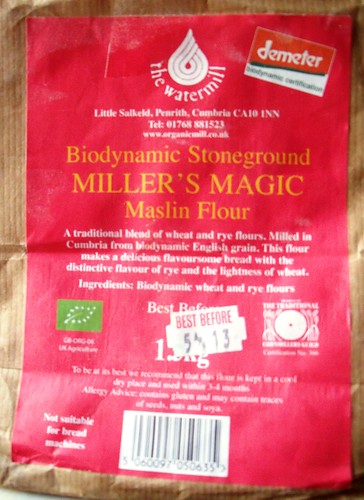
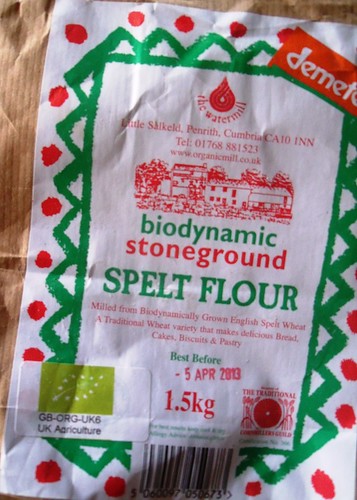





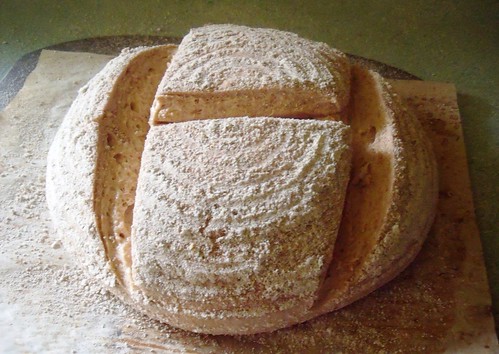
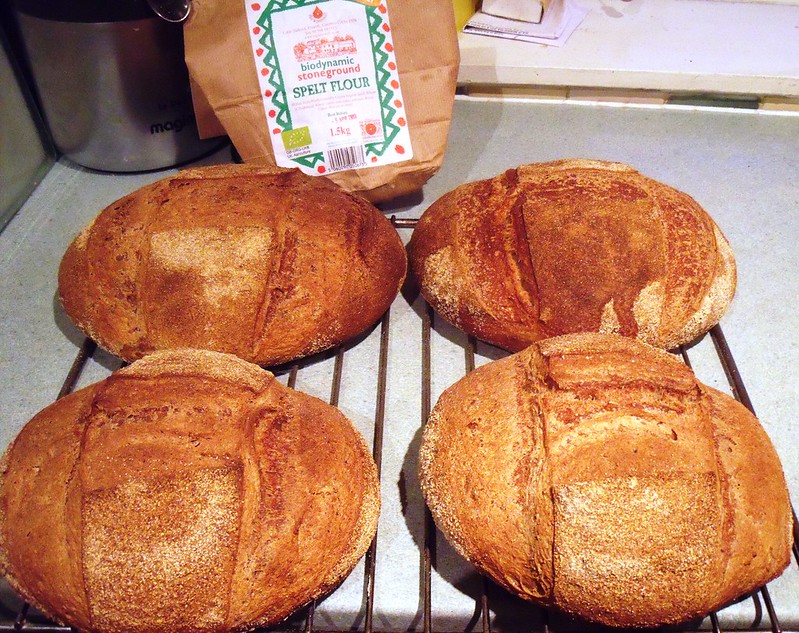




Comments
Interesting flour - rye mixed with middlings. I wonder what it tastes like. Do the middlings act like a flour or a bran? I am planning to get a finer sieve than I have now, which should leave me with some middlings. Should I mix them with rye and bake away? In any case your bread is intriguing and I would like a taste. Good to see what you are baking, and you have very nice neighbors, presumably ones who have enjoyed your bread. Happy baking indeed. -Varda
Hi Varda,
Bolting produces 3 by-products plus the white flour. Bran is the first, then Semolina, then the "Middlings". It is most definitely flour by that stage, although the colour is distinctly grey. As noted, it is the outer part of the endosperm, so it does contain some reasonable quality of protein. If you look at the photo of the mill and bolter in Franko's post, here: http://www.thefreshloaf.com/node/21368/last-loaf-2010, you can see the 3 slides underneath the cabinet on the left. Inside that cabinet is the bolter which sieves the wholemeal. The first slide when opened, will take off the bran, the middle one takes the semolina, and the one on the end is for the middlings. I don't think I feel comfortable comparing the traditional process with that of the home miller. I have never done any home milling, sorry.
The Spelt bread was our favourite...a real achievement, as I have had very bad spelt bread in the past; not an easy flour to work with oftentimes.
Many thanks for your kind words.
Best wishes
Andy
look just like the ones I bake. How nice to have the opportunity to bake with such very special flours.
"Hadrian's Bread" sounds intriguing. Reminds me of Rosemary Sutcliff's wonderful books about the Roman occupation of Britain, Hadrian's Wall, etc. I couldn't get enough of them, when I was a teenager, and knew more about English history than German.
Karin
Hi Karin,
I studied 'A' Level History, and the period we covered began with the Roman occupation of Britain. That's almost 30 years ago now.
Little Salkeld is only around 20 miles south of the Wall remains
The Spelt breads were really lovely Karin.
Very good to hear from you.
Best wishes
Andy
Hi Andy,
What special flours your neighbors kindly brought back for you - transformed into beautiful loaves :^)
For the maslin flour, does the miller disclose what the proportion is, of wheat to rye? (just curious)
The spelt bread looks great! The "H" scores opened up beautifully (as they also did on the campagne loaf).
The raisin must sounds like such a flavorful sweetener - keen to try that.
And the Moscow Rye still tempts me...I still intend to make it!
Really lovely baking, Andy - so good to see your post.
:^) breadsong
Hi Breadsong,
No, I'm afraid I don't have any idea what proportions are used in the blend of the Miller's Magic. I suspect there will be more Middlings than Rye. Unfortunately the Watermill only produce wholemeal rye. I am sure this flour would be better if they could use Light Rye [997] in place of the wholegrain flour. But they only botl wheat flour. the Spelt is wholegrain too. That is why I used my ordinary wheat levain to make these breads. When we made Hadrian's Bread at Village Bakery it was all-wholemeal, and the Spelt leaven was very temperamental. the Raisin Must was an attempt to take away a pronounced bitterness in the bread. In hindsight this has been attributed to the flour being no9ne too fresh. However, I am not necessarily convinced; I am pretty sure the high ash content in the flour made it impossible to maintain a stable leaven.
And, yes, you should make the Moscow Rye; use the 3-stage process and the Red Rye malt if at all possible.
All good wishes
Andy
to try out. They all look so well done. We have a hard time getting decent flours to try to mimic yours but continue to preserver anyway hoping for the best. Thanks for posting your formulas for the rest of us to try out We still think eventually you will deliver :-) Munching on a piece of Prune and Brazil Nut . Just delicious!
Cheers
Thank you dabrownman,
now I must get on with that business plan!
Best wishes
Andy
Hi Andy,
What a nice desplay of breads. I am interested in hearing how your customers respond to the spelt bread. I know people here either really love it or they don't like it at all. Like there is no middle ground and I am not sure why. I like mixing it with rye and love the way it adds extendability to doughs that have ww in them. Makes for a really nice feeling dough.
Thanks for the history/geography lesson.
Take Care,
Janet
Hi Janet,
I think I know why Spelt provokes such strong reactions. Those who are fans have often turned to it on account of struggling to eat bread made using regular industrially-produced wheat. Spelt is an ancient grain, and has been tampered with very little. Some people [and I emphasize "some", although they constitute a significant minority!] find Spelt bread easier to digest. Those against it have probably reacted negatively [justifiably] to particularly poor loaves of bread.
However, production systems for Spelt grain are less established, and not common. I believe this means greater inconsistency in the end product of Spelt flour...and I am looking at this "in the round", from sourcing and planting seed through harvest to milling and finally ending up with whoever is baking with the flour, and how they choose to use it. Good Spelt bread is fantastic; poor Spelt bread is terrible. This is true for all bread, of course, but the thing with Spelt is that the inconsistencies arising from ad hoc production systems exagerate the differences greatly.
Interestingly, Alison REALLY liked the Spelt loaf!
Good to hear from you
Very best wishes
Andy
Hi Andy,
I agree. Before I began baking the store bought spelt loaves I tried on my family were dense and crumbly and the kids were turned off by the mouth feel.
The loaf that I get raves about from people I bake for is the one Juergen posted awhile ago. HERE Bakes up beautifully and people don't know it is spelt at all.....just that it is really good. Many here where I live don't even know what spelt is! They just think bread is bread - either wheat or rye....Slowly I am education them to things other than what they have been exposed to. It's more than a bit of fun :-)
Take Care,
Janet
Hi Andy,
Even though I am flat out at the moment I had to stop by and say hello and comment on your great baking. I have to say I had never heard of maslin flour before and I am intrigued by it ... more research required. You don't happen to have a crumb shot for those loaves? ... they look hearty :)
Now spelt ... sigh ... I really, really want to like spelt ... and as an addition to other flours I do ... but on its own ... sigh ... I am always disappointed (except for this one time were I fluked a delicious wholegrain spelt bread ... but that was years ago) ... I am disappointed by the flavour, texture and appearance ... always feels like wheat's poor cousin :( ... how terrible of me ...
I can vouch for the poor yield on the grain ... if you try sifting it you get absolutley nothing ... so much wasted bran and goodness ...
Anyhow, dinner is on the table and I have to rush ... Great to see you posting.
All the best,
Phil
Hi Phil,
I'm just getting stuck into to writing my Business plan.
The Maslin flour, as noted in my comment to Breadsong, would be better if Light Rye was used instead of wholegrain rye. Unfortunately the Watermill only mills 100% Rye flour, so the blend ends up a little heavier than I would ideally like.
I will post a crumb shot of this loaf, but not right now, as the loaf is actually defrosting for us to enjoy over the weekend. I'll put a photo up later today, ok?
I think the fact that Spelt was the dominant production grain in Roman Britain, and subsequently fell from favour underlines your point best of all; it is wheat's poor cousin...and the reason is it is a pig to mill! Unlike modern wheat the outer husk does not just peel away from the Spelt grain, it is attached to the berry and has to be forcibly removed. Yield is pitiful, and you are quite correct about the impossibility of sifting the flour effectively. Bille Wilkinson of Gilchesters' Organics once estimated that a genuinely white Spelt flour would probably result in around about 50% extration rate!!!! Hence nearly all Spelt in the UK is wholemeal; Doves Farm and Sharpham Park seem to produce White Spelt; I wonder what they do with the by-products???
And yet when I explain to customers about how Gilchesters have selected the wheat grain they use, how it is grown and milled, I rarely manage to impress the Spelt afficionados...Spelt is all they want. I don't really get that, I'm afraid. Like you, I have seen too many bad Spelt loaves to feel that dedication to Spelt only is in anyway justifiable. When it's good, it's fantastic! But, when it's not good, it can result in very poor bread indeed.
Look out for the crumb shot here later
Always good to hear from you Phil
Very best wishes
Andy
Here is the crumbshot:
Hi Andy, great you are back.
A lovely bake with unusual flours.
Midlings - that must be similar to the Swiss "Ruchmehl". Interesting.
Your Spelt loaf also looks great.
Friends prompted me recently to use more spelt, and I am quite surprised by its versatility. (a Chocolate Chiffon cake with white spelt from Shapham Park was a real treat!)
But I agree that there is an awful lot of rather unpleasant spelt bread around in the shops.
Best Wishes,
Juergen
Hi Juergen,
Yes, from a quick check on Ruchmehl, it seems to be the same as "Middlings".
It's very good to be back, and thank you for adding your kind words; they are much appreciated
What do you make of White Spelt at 50% extraction? A waste, perhaps?
Best wishes
Andy
Lovely crafted breads i'm sure, as always. you Disappear shortly, only to resurface with a bang! Speciality flours, extraordinary persistance to baking huge varieties "ouch, the thought hurt my back!", makes me at awe of your affection to baking.
Aside from all the other lovely breads, i too agree with other tfl members who found that spelt yields less than desireable results. However, butter cookies made with whole grain spelt flour from dover farm will make a superior texture and flavor to anything wholegrain i've come across., A true treat, as Juergen said.
Best wishes, Khalid
Hi Khalid,
Yes, I've completed my studies now.
A 20 quart dough mixer with that lovely spiral hook I photographed does make light work of all the mixing of course. However, firing the oven is a different story altogether!!!
I can't find anything on "dover farm"; you don't mean "Doves Farm" do you? That is around about the most popular Organic flour brand in the UK. That's obviousdly the opposite end of the spectrum to the Watermill flours I used for this post.
As always, I very much appreciate your comments
All good wishes
Andy
Hi Andy
Great to hear from you again! Have you had the results of your studies yet?
Those breads look fantastic (as usual). Shipton Mill sell both wholemeal and white spelt flour. I bake with spelt (200g wholemeal & 200g white) on a weekly basis and use 210g of 50% hydration white flour starter. I also sometimes throw in 50 or 60g of the Watermill's 4 grain. I find that I get pretty consistent results and I love the bread toasted. It has a robust flavour that complements the homemade preserves beautifully (IMHO).
Hope you and Alison are well.
Best Wishes
Richard
Hi Richard,
Lovely to hear from you; we should catch up on the phone soon.
I don't get my results til the end of January after the Exam board!!!
Many thanks for posting your Spelt loaf formula. If anyone is going to produce consistently good Spelt flour it will be Shipton Mill. Your loaf sounds wonderful too.
Yes we are both well, if a little stressed right now.
Very best wishes
Andy
Holiday time is getting busy around here. It's wonderful to see you back on TFL and of coarse all those gorgeous WFO bakes.
Happiest of Holidays to You and Yours,
Sylvia
and hello Sylvia,
It's good to be posting here again and thank you very much for your kind words
I wish you a Happy Holiday too; although we don't get a break over in the UK for 5 weeks yet, of course.
Very best wishes
Andy
Hi Andy,
A nice treat to see one of your posts again and with a great looking selection of loaves on display. The idea of using liquefied raisins for sweetening rather than honey or sugar is a new one to me and something I'll have to try myself in a future bake. Does it add any appreciable flavour to finished loaf? I'm guessing it might give the overall flavour of the bread a bit more depth than honey or sugar would but wondering if the raisin/grape flavour comes through at all. An interesting alternative to the standard sweeteners, thanks for sharing the idea!
Cheers,
Franko
Hi Franko,
The original idea for the Raisin Must came as some of the original Spelt loaves developed at the Village Bakery back in the 1990s had a taste considered overly-bitter by many of the taste-testers. The Spelt flour used was wholemeal, and it was so uncommon at the time, that it was very difficult to obtain flour of consistent freshness and quality. Some might argue that this is still the case!
Given the loaf was named after the Roman Emperor Hadrian, the use of raisins as a sweetener seemed like an obvious way to try to counter the bitterness.
Personally, I don't think you can get away from the high ash content in the whole spelt, and the impact this had on breaking down the leaven. This was not really dealt with at the time of development, if my recollections are correct. The loaves I produced here serve as good examples of how crucial proper leaven is in any bread of this type.
You probably know I'm a bit of a Puritan when it comes to basic bread doughs. Generally, I don't have room for sweeteners in these formulae. I'm not too sure how important the raisin must is in the bread I made, but I would not consider indulging in the use of either honey, or, sugar. This is meant to be everyday eating bread made from basic staple ingredients only.
It's really good to hear from you, as always, and thank you for your generous words.
All good wishes
Andy